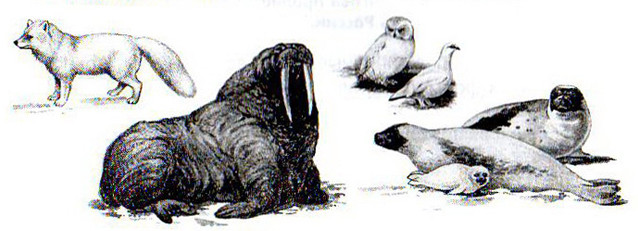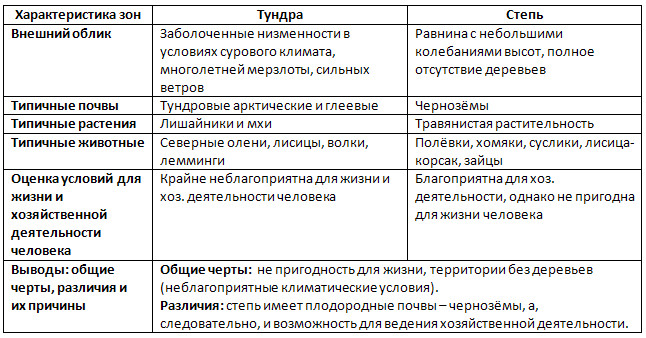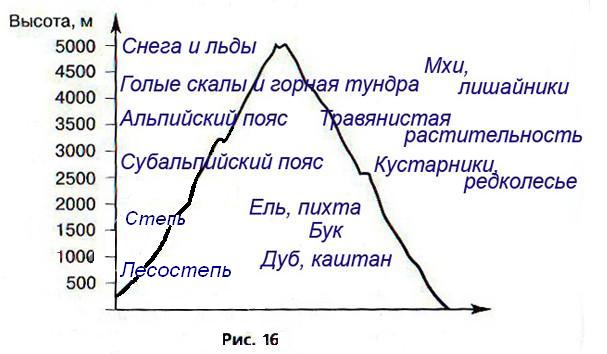Variety of natural complexes
6. What is the anthropogenic landscape? Give examples of anthropogenic landscapes in your area.
Natural and economic zones of Russia
1. What is natural zoning? What is the difference between the natural zoning of plains and mountains?
This is one of the main geographical patterns.
In the mountains - from the foot to the top, on the plains - from the equator to the poles.
2. Why is it now more correct to call natural zones natural-economic?
Currently, economic activity is carried out in absolutely all natural zones, and the scale of the influence of human activity on landscapes has become such that natural zones have essentially turned into natural-economic zones.
3. What natural zones replace each other from north to south of Russia?
Arctic deserts, tundra, forest-tundra, forest zone, forest-steppe, steppe, semi-desert, subtropical zone.
4. The natural conditions of which zones are most favorable for human life?
The natural conditions of the subtropical zone are most favorable for human life and economic activity (not too hot and not too cold).
5. The natural resources of which zones are most developed by humans?
The natural resources of the steppe zone, together with the forest-steppe, are the most developed by humans.
Arctic deserts
1. Where is the Arctic desert zone of Russia located? Why is it called the ice zone?
The Arctic desert zone is located on the islands of the Arctic Ocean and in the far north of the Taimyr Peninsula. Due to the widespread distribution of glaciers, the Arctic desert zone is often called the ice zone.
2. Find on the map and write down all the islands that are part of the ice zone.
Northern Island of Novaya Zemlya, Franz Josef Land, Severnaya Zemlya (Komsomolets Island, October Revolution Island, Bolshevik Island), New Siberian Islands (De Long Islands, Anzhu Islands, New Siberia Island, Kotelny Island ), partly about. Wrangel.
3. The ice zone is characterized by exceptional harshness of nature. Large areas of it are occupied by glaciers, and in areas free of glaciers, there is snow cover almost all year round. Using the atlas maps, determine:
Name of climate zone– Arctic belt
Average temperatures:
Winter -30⁰С
Summer +3⁰С
4. And in such harsh conditions there is life! What representatives of the fauna of the Arctic desert are shown in Figure 13? How are they adapted to life in harsh conditions?

Arctic foxes, walruses, white owls, white gulls, seals.
All birds are fed by the sea. There is a lot of algae in the sea. They feed on crustaceans, on crustaceans on fish, and on fish on birds.
Seals also feed on fish. These animals are excellent swimmers: they have an elongated, streamlined body, and their legs have turned into flippers. Seals have a thick layer of fat under their skin that protects them from the cold. Walruses are similar to seals, but much larger and have powerful fangs.
The arctic fox's body heat is retained in cold weather by its long coat and downy undercoat. By winter, the thickness of the fur increases.
5. Using various sources of geographic information (text from paragraph 33 of the textbook, atlas maps, drawings, paintings), draw up a “portrait” of the Arctic desert zone.
The Arctic desert zone is the northernmost of the natural zones, which is characterized by an arctic climate. It has low air temperatures in winter (up to -60⁰С), on average -30⁰С in January and +3⁰С in July. The spaces are covered with glaciers, rubble and fragments of stones. It is practically devoid of vegetation: there are no shrubs, lichens and mosses do not form a continuous cover.
The fauna is predominantly marine: walrus, seal, and in the summer there are bird colonies.
The terrestrial fauna is poor: arctic fox, polar bear, lemming.
Tundra and forest-tundra
1. Name the most typical features of the tundra zone, explain the reasons for their formation.
Waterlogged soils, swampiness, strong winds, low vegetation.
Causes: climate (temperature, precipitation, wind), topography and geographical location.
2. On the contour map (Fig. 14), mark the boundary of the tundra and forest-tundra zones, the boundary of permafrost and the July isotherm of +10⁰С. Write the names of large cities located in these zones.
Large cities: Murmansk, Naryan-Mar, Vorkuta, Norilsk, Salekhard.
3. What are the main types of environmental management in the northern territories?
Marine fishing, reindeer husbandry, hunting, mining.
4. What environmental problems must be solved in the tundra zone? What is the difficulty in solving them?
Poaching – it is impossible to combat illegal hunting in such a large area. Damaged by tracked vehicles, the soil layer of the tundra takes many decades to recover - other types of transport are not suitable for use in the conditions of the Far North. Pollution of the surrounding area during oil production and due to fuel leaks from oil pipelines.
1. What conditions are necessary for the spread of a forest zone?
Climate severity, degree of moisture, relief, number of sunny days, soil.
2. The forest zones of our country consist of:
Taiga, mixed and deciduous forests.
Explain the reasons for this diversity. On the contour map (Fig. 14), use symbols to show the main areas where forests of different types are located.
This diversity of forests is due to their location in different climatic zones.
3. Having studied Figure 15, draw conclusions about the possibilities of human development of the taiga zone.
Forestry, river fishing, hunting for upland game (grouse), large animals (bear, elk, wild deer) and fur-bearing animals. There are certain opportunities for agriculture in the taiga zone. They are primarily found in the southern part of the zone with relatively fertile soddy-podzolic soils.
4. Describe the climate, soils, flora and fauna of the forest zone.
The forest zone is characterized by the distribution of forest vegetation mainly of coniferous and deciduous species and the predominance of podzolic and brown earth types of soil formation.
Average air temperatures in the coldest months: from -40 to 5⁰С, in the warmest from 10 to 20⁰С. Almost everywhere more moisture falls than evaporates. The plains are swampy over vast areas.
Vegetation: coniferous, broad-leaved, mixed forests, in which moss and grass cover, undergrowth are developed.
Fauna: wolves, lynxes, bears, moose, chipmunks, sables, hares, wood grouse.
Forest-steppe and steppe
1. On the contour map (Fig. 14), mark the boundaries of the steppe zone.
2. Explain the relationship between the components of nature in the steppe zone. Show the influence of climate and vegetation on the formation of the most fertile soils in our country - chernozems.
Chernozem occurs in steppe and forest-steppe zones. The main factor in its occurrence is favorable weather conditions. In the summer, high temperatures prevail in places where chernozem naturally occurs. They improve the metabolism between soil and plants. The optimal amount of precipitation in combination with groundwater forms the required level of humidity. Otherwise, nutrients are washed out of the soil, but in the case of chernozem they are fixed in the upper layers, which gives a high level of soil fertility.
3. Russian historian V. O. Klyuchevsky wrote: “Man minutely and alternately either adapts to the nature around him, to its forces and its methods of action, or adapts them to himself, to his needs, which he cannot and does not want to give up.” " According to V. O. Klyuchevsky, the special character of the Russian person had two sources - the forest and the steppe.
Think about what character traits of a person can be formed under the influence of the steppe, and what - under the influence of the forest.
Under the influence of the forest: isolation, tendency to loneliness, going out on the road in roundabout ways, patience, enterprise.
Under the influence of the steppe: breadth of soul, freedom, daring, endurance, swiftness, intolerance.
4. Compile a description of the steppe zone according to the plan proposed in task 9 on page 180 of the textbook.
The steppe zone is located south of the forest zone. Average temperatures in winter months range from 0⁰С to -20⁰С, and in summer months from +20⁰С to +28⁰С. The annual value of thermal energy resources is more than 8000 MJ/m² per year. The growing season of plants is on average 160 days. Annual precipitation is 250-300 mm. K (humidification) = 0.4-0.5.
The relief is flat with slight variations in elevation. Annual flow is 10-15 mm. The main soils are chernozems, which have increased natural fertility and a high content of humus in the upper layers.
A characteristic feature of the steppe is the treelessness of vast plains covered with rich herbaceous vegetation.
Fauna: consumers of green and underground parts of plants predominate - voles, hamsters, gophers, hares and predators that feed on them - corsac fox, weasel. Typical species are hibernating mammals and a small number of sedentary and wintering birds.
The natural resources of the steppe zone are favorable for growing grain, especially spring wheat. The presence of meadows with sparse grass makes it possible to engage in sheep breeding.
5. Compare the treeless zones of our country.

Semi-deserts, deserts and subtropics
1. Using the atlas maps, determine which territories of Russia are located in the zone of semi-deserts and deserts.
Semi-deserts and deserts of Russia are located in the Caspian region and Eastern Ciscaucasia (Astrakhan region, Republic of Kalmykia).
2. How are plants adapted to living conditions in the desert? Draw and list the most typical plant adaptations to this climate.
Long roots to “extract” groundwater from the depths. Leaves and stems with spines or other devices that prevent moisture evaporation. Small size.
3. Semi-deserts are good pastures for sheep, camels, and horses. What needs to be done to be able to engage in farming in this area?
Irrigation of the soil is necessary.
4. The small Black Sea coast of the Caucasus in Russia belongs to the subtropical zone. Using the atlas map, determine which famous resorts are located here.
Sochi, Tuapse, Anapa, Gelendzhik.
Altitudinal zone
1. Why do natural zones change in the mountains from the foot to the top?
With altitude, temperature and pressure decrease, up to a certain altitude the amount of precipitation increases, and lighting conditions change. Due to changing climatic conditions, natural zones are also changing.
2. Based on an analysis of Figure 60 in the textbook, explain what determines the set of altitude zones in the mountains.
The number of altitude zones depends on the height of the mountains and their location.
3. Imagine that the height of the Southern Urals is 5000 m. What belts would then appear in these mountains? Label them in Figure 16, show with symbols the types of vegetation characteristic of each of the belts.

4. In which mountains of Russia is the altitudinal zonation most fully expressed? Explain why.
The Caucasus is the most striking example, because... natural conditions vary from subtropics in the lowlands of Transcaucasia to eternal snow and ice in the Greater Caucasus region. Also: Altai, Sayan Mountains, Kamchatka, Far East.
5. Find on the map and write down the cities of Russia located in mountainous regions.
Ekaterinburg, Chelyabinsk, Gorno-Altaisk, Vladikavkaz, Nalchik, Karachaevsk, Grozny.
Specially protected natural areas (SPNA)
1. List the types of protected areas that exist in Russia.

2. Based on an analysis of the atlas maps and textbook (Fig. 61), determine in which natural zones the largest number of protected areas in Russia are located.
The largest number of protected areas in Russia are located in nature reserves.
3. Under what conditions is it possible to preserve nature and ensure its sustainable development?
With rational use of natural resources, transparency in the work of environmental organizations and their close connection with public associations and the population in solving environmental problems.
4. Using various sources of information (atlas maps, textbook materials, additional literature), compose a description of one of the protected natural areas of Russia.
The Astrakhan Nature Reserve is located in the Volga Delta. Established in 1919 to protect the unique natural complex of the Volga delta, mass nesting sites for birds, mass spawning grounds for commercial fish and wintering pits.
Since 1975 it has been of international importance. The Astrakhan Nature Reserve is a kingdom of birds, of which there are more than 260 species. The reserve's workers carry out disease prevention and treatment of animals and birds, study the conditions of natural reproduction and artificial breeding of fish.
